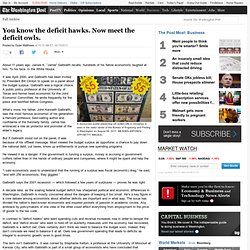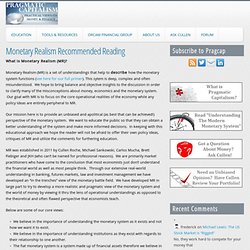

Why MMT is like an autostereogram. You know the deficit hawks. Now meet the deficit owls. About 11 years ago, James K.

“Jamie” Galbraith recalls, hundreds of his fellow economists laughed at him. To his face. In the White House. A discounted poster presenting US dollars bills in circulation is seen in the visitor center of the Bureau of Engraving and Printing in Washington on August 09, 2011. (MLADEN ANTONOV - AFP/GETTY IMAGES) It was April 2000, and Galbraith had been invited by President Bill Clinton to speak on a panel about the budget surplus. What’s more, his father, John Kenneth Galbraith, was the most famous economist of his generation: a Harvard professor, best-selling author and confidante of the Kennedy family. But if Galbraith stood out on the panel, it was because of his offbeat message. He viewed it as a danger: If the government is running a surplus, money is accruing in government coffers rather than in the hands of ordinary people and companies, where it might be spent and help the economy.
The term isn’t Galbraith’s. Keynesian roots A divisive theory. Understanding The Modern Monetary System. Modern Monetary Theory, vue par Robert Murphy. Depuis maintenant 2 ans, si ce n’est plus, on peut voir de nouveaux théoriciens sévir sur les blogs et les forums d’économie.

Ce sont les MMTers. Ils se pointent avec un argument vicié à l’encontre, qui plus est, des économistes autrichiens. Robert Murphy a publié un article réfutant leur fameuse équation “G − T = S − I”. MMT, Modern Monetary Theory, aussi appelé Chartalism, fustige la solution autrichienne aux crises économiques. L’économiste autrichien en appelle aux mesures d’austérité : baisses des dépenses publiques, des taxes, des impôts, des réglementations, des salaires.
The last point I would make, is that the UK solution is to expand the deficit at present on a discretionary basis to support the private saving desires and to build confidence among the investment community (real investments that is). Comment résumer MMT, de façon claire et concise ? The national accounts concept underpins the basic income-expenditure model that is at the heart of introductory macroeconomics. MONETARY REALISM. What is Monetary Realism (MR)?

Monetary Realism (MR) is a set of understandings that help to describe how the monetary system functions (see here for our full primer). This sytem is deep, complex and often misunderstood. We hope to bring balance and objective insights to the discussion in order to clarify many of the misconceptions about money, economics and the monetary system. Our goal with MR is to focus on the core operational realities of the economy while any policy ideas are entirely peripheral to MR. Our mission here is to provide an unbiased and apolitical (as best that can be achieved!) MR was established in 2011 by Cullen Roche, Michael Sankowski, Carlos Mucha, Brett Fiebiger and JKH (who can’t be named for professional reasons).
Below are some of our core views: To obtain a better understanding of Monetary Realism we recommend the following reading (some of which is quite advanced): 1. 2. 3. 4. 5. 6. 7. 8. 9. 10 JKH on Saving, Investment and S=I+(S-I) Why Are Banks Holding So Many Excess Reserves? - Powered by Google Docs.